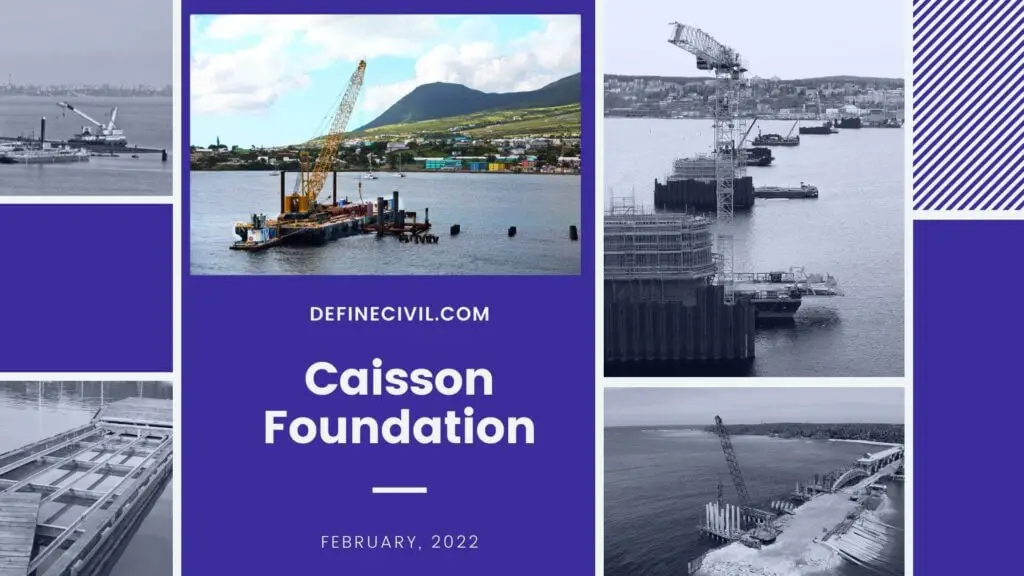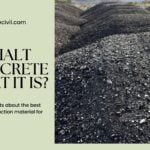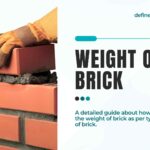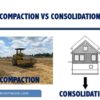Caisson foundation which is also called pier foundation is a watertight retaining structure that is made up of timber, steel, and reinforced cement concrete (RCC), and constructed for the foundation of bridges, piers and dock structures.
- Basically, the word Caisson is derived from word caisse which means a box-type structure or a watertight chamber that is used in underwater construction and for foundation of structures that are to build in rivers or in water bodies.
- It is of various shaped like round, square, rectangular, etc. which are constructed at ground then sunk into the ground at desired depth and then filled with concrete to form foundation of structure which will exclude water during excavation of foundation and will become part of structure after that.
- Caisson foundation is a type of deep foundation and similar to pile foundation that is used in underwater construction where soil strata of suitable bearing capacity is present at suitable depth below to weak soil strata.

Also Read: What is a Pier and Beam Foundation?
Functions of Caisson Foundation:
Primarily function of caisson foundation is to make space for construction of foundation under water. While Caisson foundation also prevents building from moving vertical under loading conditions. When load is applied on soil it settles down, which causes problem in structure often results in cracks. Differential settlement is most dangerous type of settlement which occurs when settlement is occurs at different rate and it leads to adverse cracks which affects the structural integrity of building thus this foundation saves buildings from differential settlements.
Similarly, in some cases when foundation is in water bodies, this causes swelling in soil which causes upward lifting of building and results in same serious differential settlement and this caisson foundation exclude water from foundation and save structure from such accidents.
Also Read: What is raft foundation – Types of Raft foundation
Application of Caisson Foundation:
- It is used for construction of piers of bridges in rivers or in water bodies.
- It is provided to exclude water from construction site.
- It is provided to give access to shafts and tunnels.
- It is used to provide space for installation of machineries and pumps in waterbodies.
- It is used in construction of multi-story buildings.
Shapes of Caisson: Caisson foundation usually includes different types of shapes depending upon type of construction and site available. Theses shapes includes:
- Basic Shape
- Circular Shape
- Rectangular Shape
- Square Shape
- Octagonal Shape
Types of Caisson Foundation:
Caisson foundation is mainly divided into three main types which includes:
- Open Caisson
- Box Caisson
- Pneumatic Caisson
Size and type of foundation employed depends upon type of structure for which we are providing.
-
Open Caisson:
Open caisson is just a hollow structure same as box which is open from both at the top and bottom. These types of foundation are used for sandy soil and for soft soil strata where soil of firmly bearing capacity is not available at higher depth.
Open caisson is constructed in reinforced cement concrete with, and middle portion is filled with sand or gravel while lower portion is filled up with concrete. Open caissons are furtherly divided based on shapes in following ways:
- Single Wall Open caisson
- Cylindrical Open Caissons
- Open caissons with dredging wells.
Also Read: Foundation Failure – (Read it before its TOO Late)
Construction of Open Caissons:
Construction of open caisson is done by following conditions:
- Dry Condition
- Dewatered Condition
- Artificial Island
If dry condition is not generally available, then caissons are built in barges or spillways and then it is towed down to its final position by floating. And guide piles are used for sinking first few caissons. Sinking of caissons is only done in open water.
If dredging of soil is done, then caissons sink automatically, based on their own weight. Thus, excavation is done based on dredging and the soil left near cutting is removed with the help of manpower. Caissons are displaced down to require depth then concrete seal cap is provided and dewatering condition is achieved through pumping system.
In case of artificial island, which is also called sand island method, island is made by elevating ground surface above the water level temporarily for obtaining dry condition for sinking process. Size of artificial island is kept large, so it provides more working space all around the caissons.
-
Box Caissons:
- Box caissons are watertight boxes similar to open caissons, with the only difference that they are closed at the bottom.
- Box caissons are usually made up of heavy timber, steel, and reinforce cement concrete (RCC).
- Box caissons are provided where soil of suitable bearing capacity is present at shallow depth.
- Box caissons are casted and cured completely on ground and then displaced in water by filling empty spaces by sand, gravel, or concrete.
-
Pneumatic Caissons:
These are also watertight boxes, made up of timber, steel, and reinforce concrete, which are close at top while open at bottom, and generally used at a location where it is not possible to construct a well and where depth of water is more than 12 meters.
For the construction of pneumatic caissons, compressed air is used for removing excess water from working chamber for getting dry condition so that foundation work is done.
Construction of Caisson foundations:
Caisson foundations are constructed by following processes:
- Prefabrication of Caisson:
- First of all, prefabrication of caissons is done near the construction site or at suitable available location.
- When prefabrication is done, prefabricated structure is tested for water tightness so that no leakage of water is possible through this caisson otherwise, they will be repaired.
- Transportation of Caisson:
After prefabrication and testing of caissons, they are transported to required location by following all precautionary measure.
- Positioning and Immersion of Caissons:
When transportation of caissons is done, next phase is to observe keenly that caissons are properly positioned at desired place. Tugboats, cables from floating equipment, anchors or dead-man beds are used for final positioning of caissons.
When caissons are ready, next phase is to immerse them into ground. For which, soil is dug out from work chamber which allows the caissons to immerse into ground. Excavation is done with the help of sand pumps and machinery and excavated soil is removed with the help of hydraulic transport system
Caisson subsides freely under its own weight. When it is subsided to a suitable depth, then work chamber is completely filled with concrete which will prevent further sinking.
- Ballasting: After caissons are immersed, they are ballasted to attain maximum stability.
Advantages of Caisson Foundations:
- They are easily adaptable for different site conditions.
- Caisson foundations are economical as compared to piling.
- They have high load bearing capacity.
- There construction is easy and less noisy.
- Available in different shapes for different types of structures.
Disadvantages of Caisson Foundations:
- Lack of expertise and qualified workers for designing and installing caisson foundations.
- These are sensitive to polluted environment.
- Underwater concreting is done, which is not satisfactory.
- These are sensitive to manufacturing processes.
Further Read: Advantages and Disadvantages of Raft Foundation

















